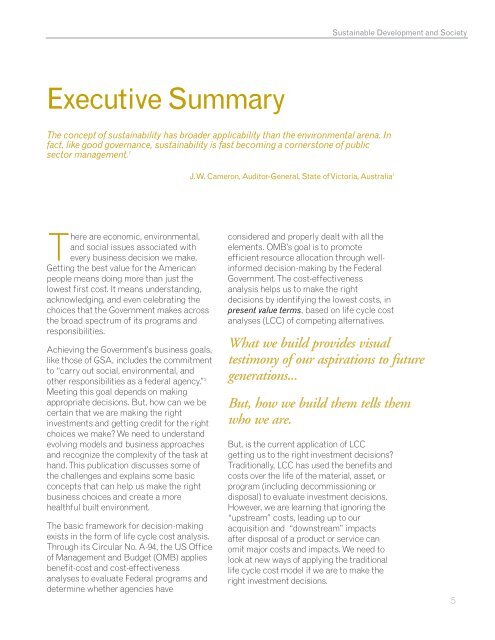Sustainable Development and Society - GSA
Sustainable Development and Society - GSA
Sustainable Development and Society - GSA
Create successful ePaper yourself
Turn your PDF publications into a flip-book with our unique Google optimized e-Paper software.
<strong>Sustainable</strong> <strong>Development</strong> <strong>and</strong> <strong>Society</strong><br />
Executive Summary<br />
The concept of sustainability has broader applicability than the environmental arena. In<br />
fact, like good governance, sustainability is fast becoming a cornerstone of public<br />
sector management. 1 J. W. Cameron, Auditor-General, State of Victoria, Australia 1<br />
There are economic, environmental,<br />
<strong>and</strong> social issues associated with<br />
every business decision we make.<br />
Getting the best value for the American<br />
people means doing more than just the<br />
lowest first cost. It means underst<strong>and</strong>ing,<br />
acknowledging, <strong>and</strong> even celebrating the<br />
choices that the Government makes across<br />
the broad spectrum of its programs <strong>and</strong><br />
responsibilities.<br />
Achieving the Government’s business goals,<br />
like those of <strong>GSA</strong>, includes the commitment<br />
to “carry out social, environmental, <strong>and</strong><br />
other responsibilities as a federal agency.” 2<br />
Meeting this goal depends on making<br />
appropriate decisions. But, how can we be<br />
certain that we are making the right<br />
investments <strong>and</strong> getting credit for the right<br />
choices we make? We need to underst<strong>and</strong><br />
evolving models <strong>and</strong> business approaches<br />
<strong>and</strong> recognize the complexity of the task at<br />
h<strong>and</strong>. This publication discusses some of<br />
the challenges <strong>and</strong> explains some basic<br />
concepts that can help us make the right<br />
business choices <strong>and</strong> create a more<br />
healthful built environment.<br />
The basic framework for decision-making<br />
exists in the form of life cycle cost analysis.<br />
Through its Circular No. A-94, the US Office<br />
of Management <strong>and</strong> Budget (OMB) applies<br />
benefit-cost <strong>and</strong> cost-effectiveness<br />
analyses to evaluate Federal programs <strong>and</strong><br />
determine whether agencies have<br />
considered <strong>and</strong> properly dealt with all the<br />
elements. OMB’s goal is to promote<br />
efficient resource allocation through wellinformed<br />
decision-making by the Federal<br />
Government. The cost-effectiveness<br />
analysis helps us to make the right<br />
decisions by identifying the lowest costs, in<br />
present value terms, based on life cycle cost<br />
analyses (LCC) of competing alternatives.<br />
What we build provides visual<br />
testimony of our aspirations to future<br />
generations...<br />
But, how we build them tells them<br />
who we are.<br />
But, is the current application of LCC<br />
getting us to the right investment decisions?<br />
Traditionally, LCC has used the benefits <strong>and</strong><br />
costs over the life of the material, asset, or<br />
program (including decommissioning or<br />
disposal) to evaluate investment decisions.<br />
However, we are learning that ignoring the<br />
“upstream” costs, leading up to our<br />
acquisition <strong>and</strong> “downstream” impacts<br />
after disposal of a product or service can<br />
omit major costs <strong>and</strong> impacts. We need to<br />
look at new ways of applying the traditional<br />
life cycle cost model if we are to make the<br />
right investment decisions.<br />
5

















